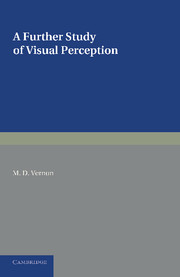Book contents
- Frontmatter
- Contents
- List of Illustrations
- Acknowledgements
- Chapter I INTRODUCTION
- Chapter II THE NATURE OF PERCEPTION
- Chapter III THE PERCEPTUAL PROCESS
- Chapter IV THE DETERMINATION OF FORM
- Chapter V SPATIAL PERCEPTION
- Chapter VI THE CONSTANCIES
- Chapter VII THE FUNCTIONS OF THE FRAMEWORK IN PSYCHO-PHYSICAL EXPERIMENTS
- Chapter VIII THE PERCEPTION OF MOVEMENT
- Chapter IX MICHOTTE'S STUDIES OF SOME INTRINSIC PHENOMENA OF EXPERIENCE
- Chapter X THE INFLUENCE OF INTERNAL AND INDIVIDUAL FACTORS UPON PERCEPTION
- Chapter XI CONCLUSION
- Appendix A
- Appendix B
- References
- Index of Authors
- Index of Subjects
Chapter IX - MICHOTTE'S STUDIES OF SOME INTRINSIC PHENOMENA OF EXPERIENCE
Published online by Cambridge University Press: 05 June 2016
- Frontmatter
- Contents
- List of Illustrations
- Acknowledgements
- Chapter I INTRODUCTION
- Chapter II THE NATURE OF PERCEPTION
- Chapter III THE PERCEPTUAL PROCESS
- Chapter IV THE DETERMINATION OF FORM
- Chapter V SPATIAL PERCEPTION
- Chapter VI THE CONSTANCIES
- Chapter VII THE FUNCTIONS OF THE FRAMEWORK IN PSYCHO-PHYSICAL EXPERIMENTS
- Chapter VIII THE PERCEPTION OF MOVEMENT
- Chapter IX MICHOTTE'S STUDIES OF SOME INTRINSIC PHENOMENA OF EXPERIENCE
- Chapter X THE INFLUENCE OF INTERNAL AND INDIVIDUAL FACTORS UPON PERCEPTION
- Chapter XI CONCLUSION
- Appendix A
- Appendix B
- References
- Index of Authors
- Index of Subjects
Summary
MECHANICAL CAUSALITY AND ‘INTENTIONALITY’
Of recent years certain particular types of movement phenomena have been studied by Michotte in a series of most interesting and ingenious experiments. The earliest of these were devoted to the phenomenal impressions obtained when one object is set in motion and comes into contact with a second object which then begins to move in turn. With suitable conditions of velocity and direction of movement of the two objects, an immediate impression of causality is obtained—that is to say, the movement of the second object appears to be caused by the impact of the first. This impression is as simple, direct, and fundamental as is the impression of movement in the phi phenomenon. It does not depend upon reasoning or on previous experience, or even, within certain limits, upon the nature of the moving objects. But it is constituted by a specific organized system of sensory impressions—that is to say, a particular configuration of position, direction, and speed of movement. This configuration is analogous, or rather complementary, to that constituting the phi phenomenon.
Michotte in his experiments (1946) did not use real objects, one of which actually set the other in motion. Arcs of circles and curves having various angular directions were marked on a disc which rotated behind the slot in a screen in such a way that a black square, A, was seen moving along the slot until it touched a red square, B, which then began moving in turn (see Fig. 23). (The results were confirmed by projecting moving squares from a projector on to a screen.) In one set of experiments, A remained motionless when it had touched B; in a second set, A continued to move along behind B and in contact with it. In the first set, A appeared to launch, push, or propel B (‘l'effet Lancement’); in the second set, A appeared to carry B along with it (‘l'effet Entraînement’).
- Type
- Chapter
- Information
- A Further Study of Visual Perception , pp. 183 - 199Publisher: Cambridge University PressPrint publication year: 2013



